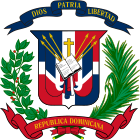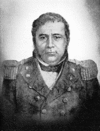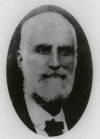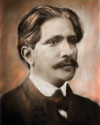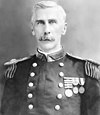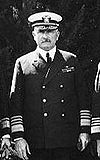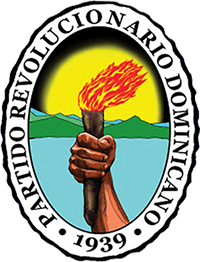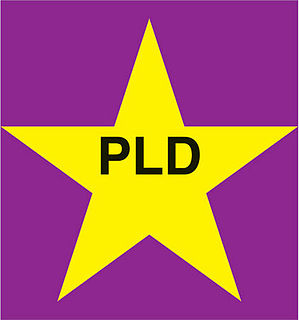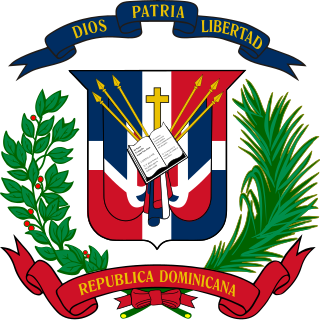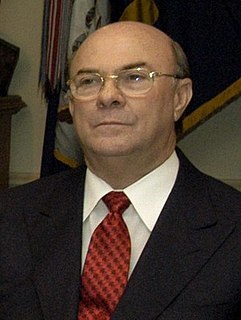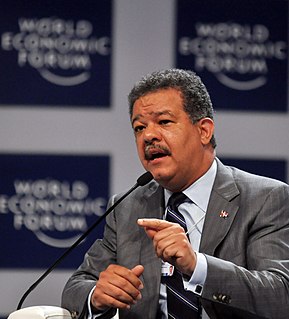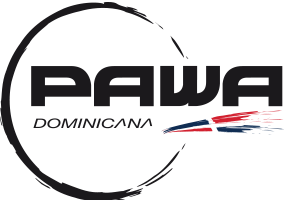| Portrait | Name
(Birth–Death) | Term of office | Elections | Political
party | Notes |
|---|
| Start | End |
|---|
|  | Pedro Antonio Pimentel
(1830–1874) | 11 July 1865 | 4 August 1865 | — | — | Ousted from office by a coup d'état. |
|---|
| 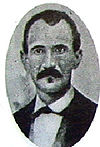 | José María Cabral
(1816–1899) | 4 August 1865 | 15 November 1865 | — | Blue | Cabral was proclaimed "Protector of the Republic" until the election of a new president by the National Convention. |
|---|
|  | Pedro Guillermo
(1814–1867) | 15 November 1865 | 8 December 1865 | — | — | Guillermo was appointed as Interim President until the arrival to the Dominican Republic of Buenaventura Báez, who was exiled in Curaçao. |
|---|
|  | Buenaventura Báez
(1812–1884) | 8 December 1865 | 29 May 1866 | 1865 | Red | Ousted from office by a coup d'état. |
|---|
| | Triumvirate | 29 May 1866 | 22 August 1866 | — | — | Members: Pedro Antonio Pimentel, Gregorio Luperón, Federico de Jesús García.
The Electoral College system was abolished and replaced by universal direct suffrage. |
|---|
|  | José María Cabral
(1816–1899) | 22 August 1866 | 29 September 1866 | — | Blue | Interim president. |
|---|
| 29 September 1866 | 31 January 1868 | 1866 | Blue | Cabral was the first Dominican president elected by universal direct suffrage. Ousted from office by a coup d'état. |
|  | Manuel Altagracia Cáceres
(1838–1878) | 31 January 1868 | 13 February 1868 | — | — | |
|---|
| | Junta of Generals | 13 February 1868 | 2 May 1868 | — | — | Members: José Antonio Hungría, Francisco Antonio Gómez Báez, José Ramón Luciano y Franco. |
|---|
|  | Buenaventura Báez
(1812–1884) | 2 May 1868 | 2 January 1874 | 1868 | Red | Ousted from office by defeat in the Six Years' War. |
|---|
|  | Ignacio María González
(1838–1915) | 25 November 1873 | 21 January 1874 | — | Green | Supreme chief. |
|---|
| 
 | Ignacio María González
(1838–1915)
Manuel Altagracia Cáceres
(1838–1878) | 21 January 1874 | 5 February 1874 | — | — | Generals in charge of the Supreme Power of the Nation. |
|---|
|  | Ignacio María González
(1838–1915) | 5 February 1874 | 23 February 1876 | 1874 | Green | Resigned. |
|---|
| | Council of Secretaries of State | 23 February 1876 | 29 April 1876 | — | — | Members: Pedro Tomás Garrido Matos, José de Jesús Eduardo de Castro Álvarez, Pedro Pablo de Bonilla y Correa-Cruzado, Juan Bautista Zafra y Miranda, Pablo López Villanueva (until 7 March 1876), Jacinto Peynado y Tejón (since 7 March 1876). |
|---|
|  | Ulises Francisco Espaillat
(1823–1878) | 29 April 1876 | 5 October 1876 | 1876 | Blue | Ousted from office by a coup d'état. |
|---|
| | Superior Governing Junta | 5 October 1876 | 11 November 1876 | — | — | Members: Pedro Tomás Garrido Matos, José de Jesús Eduardo de Castro Álvarez, Juan Bautista Zafra y Miranda, Pablo López Villanueva, José Caminero Matías, Fidel Rodríguez Urdaneta, Juan Esteban Ariza Matos. |
|---|
|  | Ignacio María González
(1838–1915) | 11 November 1876 | 9 December 1876 | — | Green | Resigned. |
|---|
| | Marcos Antonio Cabral
(1842–1903) | 10 December 1876 | 26 December 1876 | — | — | President of the Provisional Government Junta. |
|---|
|  | Buenaventura Báez
(1812–1884) | 27 December 1876 | 2 March 1878 | — | Red | Ousted from office by a coup d'état. |
|---|
|  | Ignacio María González
(1838–1915) | 1 March 1878 | 3 May 1878 | — | Green | President of the Provisional Government of the National Movement. |
|---|
| | Council of Secretaries of State | 2 March 1878 | 5 March 1878 | — | — | Members: José María Cabral, Joaquín Montolío. |
|---|
|  | Cesáreo Guillermo
(1847–1885) | 5 March 1878 | 6 July 1878 | — | Red | Interim president. |
|---|
|  | Ignacio María González
(1838–1915) | 6 July 1878 | 2 September 1878 | 1878 | Green | Ousted from office by a coup d'état. |
|---|
| | Superior Leaders of the Revolutionary Movement | 2 September 1878 | 6 September 1878 | — | — | Members: Ulises Heureaux, Cesáreo Guillermo. |
|---|
| 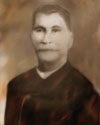 | Jacinto de Castro
(1811–1896) | 7 September 1878 | 29 September 1878 | — | — | President of the Supreme Court of Justice. Resigned. |
|---|
| | Council of Secretaries of State | 30 September 1878 | 27 February 1879 | — | — | Members: Cesáreo Guillermo, Alejandro Angulo Guridi, Pedro María Aristy. |
|---|
|  | Cesáreo Guillermo
(1847–1885) | 27 February 1879 | 6 December 1879 | 1879 | Red | Ousted from office by a coup d'état. |
|---|
|  | Gregorio Luperón
(1839–1897) | 6 October 1879 | 1 September 1880 | — | Blue | |
|---|
| 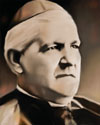 | Fernando Arturo de Meriño
(1833–1906) | 1 September 1880 | 1 September 1882 | 1880 | Blue | |
|---|
|  | Ulises Heureaux
(1845–1899) | 1 September 1882 | 1 September 1884 | 1882 | Blue | |
|---|
|  | Francisco Gregorio Billini
(1844–1898) | 1 September 1884 | 16 May 1885 | 1884 | Blue | Resigned. |
|---|
|  | Alejandro Woss y Gil
(1856–1932) | 16 May 1885 | 6 January 1887 | — | Blue | Vice-president under Francisco Gregorio Billini, assumed the presidency after his resignation. |
|---|
|  | Ulises Heureaux
(1845–1899) | 6 January 1887 | 27 February 1889 | 1886 | Blue | |
|---|
| 27 February 1889 | 27 February 1893 | 1888 | Blue | |
| 27 February 1893 | 27 February 1897 | 1892 | Blue | |
| 27 February 1897 | 26 July 1899 | 1896 | Blue | Assassinated. |
| | Wenceslao Figuereo
(1834–1910) | 26 July 1899 | 30 August 1899 | — | Blue | Vice-president under Ulises Heureaux, assumed the presidency after his assassination. Ousted from office by a coup d'état. |
|---|
| | Council of Secretaries of State | 31 August 1899 | — | — | Members: Tomás Demetrio Morales, Arístides Patiño, Enrique Henríquez y Alfau, Jaime R. Vidal, Braulio Álvarez. |
|---|
| | People's Revolutionary Governing Junta | 31 August 1899 | 4 September 1899 | — | — | Members: Mariano Cestero, Álvaro Logroño, Arístides Patiño, Pedro María Mejía. |
|---|
|  | Horacio Vásquez
(1860–1936) | 4 September 1899 | 15 November 1899 | — | Red | Interim president. |
|---|
|  | Juan Isidro Jimenes Pereyra
(1846–1919) | 15 November 1899 | 2 May 1902 | 1899 | Blue | Ousted from office by a coup d'état. |
|---|
|  | Horacio Vásquez
(1860–1936) | 26 April 1902 | 23 April 1903 | — | Red | Ousted from office by a coup d'état. |
|---|
|  | Alejandro Woss y Gil
(1856–1932) | 23 March 1903 | 1 August 1903 | — | Blue | Interim president. |
|---|
| 1 August 1903 | 24 November 1903 | 1903 | Blue | Ousted from office by a coup d'état. |
|  | Carlos Felipe Morales
(1868–1914) | 24 November 1903 | 17 June 1904 | — | Red | Interim president. |
|---|
| 17 June 1904 | 24 December 1905 | 1904 | Red | Resigned. |
| | Council of Secretaries of State | 24 December 1905 | 29 December 1905 | — | — | Members: Manuel Lamarche García, Emiliano Tejera, Andrés Julio Montolío, Francisco Leonte Vásquez Lajara, Carlos Ginebra, Eladio Victoria, Federico Velásquez y Hernández. |
|---|
|  | Ramón Cáceres
(1866–1911) | 29 December 1905 | 1 July 1908 | — | Red | Vice-president under Carlos Felipe Morales, assumed the presidency after his resignation. |
|---|
| 1 July 1908 | 19 November 1911 | 1908 | Red | Assassinated at the start of the 1911–12 Civil War. |
| | Council of Secretaries of State | 19 November 1911 | 5 December 1911 | — | — | Members: Miguel Antonio Román, José María Cabral. |
|---|
|  | Eladio Victoria
(1864–1939) | 5 December 1911 | 27 February 1912 | — | — | Interim president appointed by the Congress. |
|---|
| 27 February 1912 | 30 November 1912 | 1912 | — | Resigned. |
|  | Adolfo Alejandro Nouel
(1862–1937) | 1 December 1912 | 13 April 1913 | — | — | Archbishop of Santo Domingo, interim president appointed by the Congress. Resigned. |
|---|
| 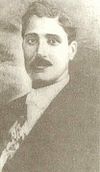 | José Bordas Valdez
(1874–1968) | 14 April 1913 | 15 June 1914 | — | — | Interim president appointed by the Congress. |
|---|
| 15 June 1914 | 27 August 1914 | June
1914 | — | Resigned. |
| | Ramón Báez
(1858–1929) | 28 August 1914 | 5 December 1914 | — | — | Interim president. |
|---|
|  | Juan Isidro Jimenes Pereyra
(1846–1919) | 6 December 1914 | 4 May 1916 | Oct.
1914 | Blue | |
|---|
